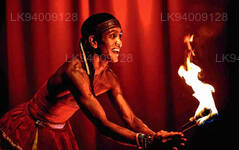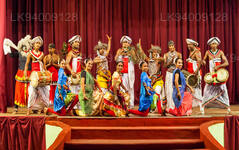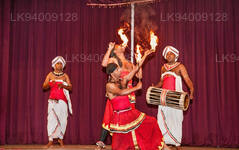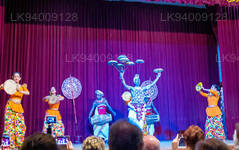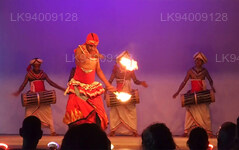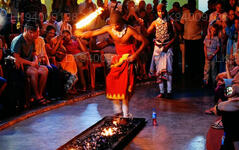
مدينة كاندي
كاندي، مدينة خلابة في وسط سريلانكا، تشتهر بتراثها الثقافي الغني ومهرجاناتها النابضة بالحياة وجمالها الطبيعي الأخّاذ. تقع وسط تلال خضراء، وتضم معبد السنّ، وهو موقع تراث عالمي لليونسكو، وتوفر مزيجًا آسرًا من التاريخ وروعة الطبيعة.
Kandy Cultural Show
The Kandy Lake Club Cultural Dance Show is a stimulating Sri Lankan Arts, Dance & Cultural Heritage Show that is a must see for any visitor who visits the historic city of Kandy. The Kandy Lake Club Dance started in 1982 with the view of having a cultural dance performance bringing together all Sri Lankan dance types to one platform. It is the first Cultural Dance Show of its kind to be established in Sri Lanka. It has since become a tourist attraction for many people visiting the country and keen on a glimpse of its rich cultural heritage. Hence it has been performing continuously for the last 35 years. Dance techniques unique to areas of the island are usually passed on from generation to generation. These Dances are performed at local ceremonies and rituals using drums and costumes that are unique to each area. Among the attractions are the Dances depicting the majestic walk of the elephant, colourful performance of the peacock and the mystical movements of the cobra. There are also dances with traditional masks, traditional drums and flames. The show ends with the unbelievable feat of walking on red-hot charcoal, which is a traditional form of worship of local gods. Right throughout the show you can enjoy the sounds of drums and other traditional musical instruments of Sri Lanka.  A hand out in different languages gives our customers a description of every item with all interesting facts and features of the dance show.
The Kandy Lake Club Cultural Dance Show is a stimulating Sri Lankan Arts, Dance & Cultural Heritage Show that is a must see for any visitor who visits the historic city of Kandy. The Kandy Lake Club Dance started in 1982 with the view of having a cultural dance performance bringing together all Sri Lankan dance types to one platform. It is the first Cultural Dance Show of its kind to be established in Sri Lanka. It has since become a tourist attraction for many people visiting the country and keen on a glimpse of its rich cultural heritage. Hence it has been performing continuously for the last 35 years.
- Magul Bera: The blowing of the Conch Shell is the traditional invocation at the commencement of any function and the drums are an integral part of the ritual. It is an ancient Sinhala custom to present ritual music when seeking the blessings of the Guardian of the land.
- Puja Natuma: The female dancers carrying oil lamps are making an offering of their dancing skills to the Guardian Deities.
- Devol Natuma: A dance sequence performed for general immunity from evil influences as well as for healing specific ailments. It is a part of a ceremony connected with folk believes. The vigorous movements of the dancers are derived from the dance forms of the Southern parts of Sri Lanka.
- Mayura Natuma:The female dancers depict the graceful movements of the peacock which according to mythology is the bird that transports Skanda, the War-God of Ceylon, worshipped by Buddhists and Hindus alike.
- Pantheru Natuma: The name of the dance is derived from the musical instrument used, the pantheru, which is close akin to the tambourine. Rhythm is also provided by the accompanying drums. The dance itself shows Sinhala warriors on their way to battle.
- Raksha Natuma: A South Sri Lanka mask dance with the raksha masks symbolising the fight between a cobra and a bird. This dance is used to exorcise demons from the possessed and is still believed to be effective psychiatric treatment in Sri Lanka.
- Lee Keli Natuma: A dance popular in the all parts of the country, particularly during festivals in which both male and female dancers participate. Each dancer has two sticks and the sound of the sticks striking each other together with those of the accompanying drums provide the rhythm for the dancers.
- Raban Natuma: A traditional folk dance which uses the Rabana, an instrument similar to the drum. The popular Ath Rabana (hand Rabana) is almost one foot in diameter and is both played and wielded in a variety of forms by the male and female dancers. Raban playing is accompanied by singing too.
- Gini Sisila: A south Ceylon fire dance showing the power of charms over fire and the twenty seven devils that can trouble mankind. The absolute faith of the fire dancers protects them from the flames. This dance also includes fire-eating.
- Ves Natuma: This dance is the one of the most important forms of Kandyan dance. Ves is the traditional attire of the Kandyan dancer. Sixty four ornaments complete the dress and traditionally their sheen symbolizes the rays of the sun. It takes years of rigorous training before a dancer can achieve the status of a fully-fledged ves dancer.
- Kulu Natuma: A traditional folk dance performed by village damsels to celebrate a rich harvest. The dance portrays sequences from reaping to winnowing of the grain. This is a buoyant dance providing ample opportunities for displaying feminine grace. It is performed to the accompaniment of light drum beats and the haunting strains of the flute.
- Fire walking: The origin of fire walking can be traced back to the epic story of Rama and Sita. Ravana, the King of Ceylon, had abducted the princess of India, Sita. When Rama her husband (an Indian King) regained her, she proved her chastity during her enforced stay with Ravana, by walking on fire, barefoot and unhurt. The devotees who perform fire-walking seek the divine blessings of Lord Kataragama and Goddess Pattini before they do so.
During the show, you will see several dances which depict the graceful movements of birds and animals, which trace their origins back to the ancient ritual known as the Kohomba Kapkariya, as well as energetic acrobatic performances where the men perform a series of leaping pirouettes and stunts such as plate-spinning and the dramatic ‘fire walk’ which ends the show.
حول مقاطعة كاندي تقع مقاطعة كاندي في المقاطعة الوسطى لسريلانكا. كانت كاندي، وهي واحدة من مواقع التراث العالمي السبعة في سريلانكا، موطنًا لملوك كاندي في القرن السادس عشر ومنبعًا لجميع الموسيقى والفنون والحرف والثقافة في البلاد. تقع كاندي على بعد حوالي 129 كم من كولومبو، وسط تضاريس جبلية وتنجذب جميع الأنظار إلى وسط المدينة، حيث تشكل بحيرة كاندي ميزة ساحرة. تحتفظ كاندي بأهمية دينية كبيرة لسريلانكا، لأنه في هذه المدينة الساحرة يقع دالادا ماليغاوا أو "معبد السن"، والذي يقع بداخله بقايا السن المقدسة للرب بوذا المحروسة جيدًا. تقع الحديقة النباتية الملكية، بيرادينيا على بعد حوالي 5 كم إلى الغرب من وسط المدينة في بيرادينيا ويزورها 1.2 مليون شخص سنويًا. إنها أكبر حديقة نباتية في الجزيرة. غابة أوداواتا (أوداواتا كيلي) محمية طبيعية تقع في قلب المدينة، شمال معبد السن مباشرةً. مدينة كاندي ذات أغلبية سنهالية؛ وتضم مجتمعات كبيرة تنتمي إلى مجموعات عرقية أخرى، مثل المور والتاميل. تأتي كاندي في المرتبة الثانية بعد كولومبو، مركز الاقتصاد السريلانكي. للعديد من الشركات الكبرى فروع كبيرة في كاندي، وتوجد العديد من الصناعات فيها، بما في ذلك المنسوجات والأثاث وتكنولوجيا المعلومات والمجوهرات. كما تضم المدينة العديد من مراكز البحوث الزراعية. وتُعدّ كاندي منبعًا لجميع أنواع الموسيقى والفنون والحرف اليدوية والثقافة في البلاد. تبعد كاندي حوالي 129 كم عن كولومبو، وتقع وسط تضاريس جبلية، وتتجه الأنظار إلى مركز المدينة، حيث تُشكّل بحيرة كاندي معلمًا ساحرًا. تحتفظ كاندي بأهمية دينية كبيرة لسريلانكا، وذلك لأنها المدينة الساحرة التي يقع فيها دالادا ماليجاوا أو معبد توتيس، والذي يقع بداخله بقايا الأسنان المقدسة للرب بوذا المحروسة جيدًا. نبذة عن المقاطعة المركزية تتكون المقاطعة المركزية لسريلانكا في المقام الأول من التضاريس الجبلية. تبلغ مساحة المقاطعة 5674 كيلومترًا مربعًا، ويبلغ عدد سكانها 2421148 نسمة. تشمل بعض المدن الرئيسية كاندي وجامبولا (24730) ونوار إيليا وباندارويلا. يتكون السكان من مزيج من السنهاليين والتاميل والمور. تقع كل من عاصمة التلال كاندي ومدينة نوارا إيليا داخل المقاطعة المركزية وكذلك سري بادا. تنتج المقاطعة الكثير من شاي سيلان الشهير، الذي زرعه البريطانيون في ستينيات القرن التاسع عشر بعد أن قتل مرض مدمر جميع مزارع البن في المقاطعة. تجذب المقاطعة الوسطى العديد من السياح، مع مدن محطات التلال مثل كاندي وجامبولا وهاتون ونوارا إيليا. سن المعبد أو دالادا ماليغاوا هو المكان المقدس الرئيسي في مقاطعة سنترال. المناخ بارد، وغالبًا ما يكون لدى العديد من المناطق التي يبلغ ارتفاعها حوالي 1500 متر ليالٍ باردة. المنحدرات الغربية رطبة جدًا، حيث يبلغ معدل هطول الأمطار في بعض الأماكن ما يقرب من 7000 ملم سنويًا. المنحدرات الشرقية هي أجزاء من منطقة الجفاف المتوسط حيث تتلقى الأمطار فقط من الرياح الموسمية الشمالية الشرقية. تتراوح درجات الحرارة من 24 درجة مئوية في كاندي إلى 16 درجة مئوية فقط في نوارا إيليا، التي تقع على ارتفاع 1889 مترًا فوق مستوى سطح البحر. تقع أعلى الجبال في سريلانكا في المقاطعة الوسطى. التضاريس جبلية في الغالب، مع وجود وديان عميقة تقطعها. المنطقتان الجبليتان الرئيسيتان هما الكتلة الجبلية الوسطى وسلسلة جبال نكلز إلى الشرق من كاندي.

